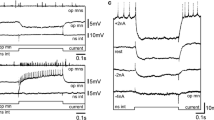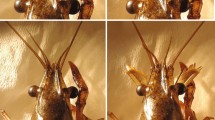Summary
-
1.
In the antenna ofGerris two forms of bipolar, extracellular single action potentials have been recorded: negative-positive (NP potentials) and positive-negative (PN potentials).
-
2.
The main source of the afferent NP potentials is the distal half of the pedicellus, as shown by amputation and coagulation experiments (Fig. 13).
-
3.
There is a reciprocal relationship between spontaneous sensory activity and efferent PN activity.
-
4.
The reaction of PN units is comparable to the response of off-neurones to optical stimulation of the eye. The effects depend on light intensity (Fig. 9). It was also possible to record light-activated NP units, with phasic on-responses (Fig. 10).
-
5.
Each antenna has at least three PN-units of its own. Temporal correlation of PN activity patterns exists between the two antennae; these activity patterns usually alternate (Fig. 8).
-
6.
PN units are inhibited by: touching the body, air puffs, vibration of tarsi and bending of joints of legs and antennae (Figs. 13, 14). Because of this inhibition, PN units are silent during escape and antennal movements (Fig. 6). Therefore PN impulses cannot be action potentials of antennal muscles.
-
7.
Because PN impulses have a conductive delay to the distal half of the pedicellus (Fig. 3), and passive electrical spread of potentials in the antenna is instantaneous (see test impulse Figs. 4, 5, 11c), it is concluded that efferent PN axons extend into the pedicellus. Two other facts support the suggested active conduction of PN impulses.
-
8.
Because of the absence of muscles in the pedicellus and flagellum, one must conclude that PN impulses are not motor, but probably innervate sensory cells. The significance of such an innervation is discussed.
Similar content being viewed by others
References
Anwyl, R., Finlayson, L. H.: Peripherally and centrally generated action potentials in neurons with both a motor and a neurosecretory function in the insectRhodnius prolixus. J. comp. Physiol.91, 135–145 (1974)
Blest, A. D., Collett, T. S.: Micro-electrode studies of the medial protocerebrum of some Lepidoptera. I. Responses to simple, binocular visual stimulation. J. Insect Physiol.11, 1079–1103 (1965)
Boeckh, J.: Die Reaktionen olfaktorischer Neurone im Deutocerebrum von Insekten im Vergleich zu den Antwortmustern der Geruchssinneszellen. J. comp. Physiol.90, 183–205 (1974)
Burkhardt, D., Schneider, G.: Die Antennen vonCalliphora als Anzeiger der Fluggeschwindigkeit. Z. Naturforsch.12b, 139–143 (1957)
Dingle, H., Caldwell, R. L.: Multimodal interneurons in cockroach cerebrum. Nature (Lond.)215, 63–64 (1967)
Gewecke, M.: Bewegungsmechanismus und Gelenkreceptoren der Antenne vonLocusta migratoria L. (Insecta, Orthoptera). Z. Morph. Tiere71, 128–149 (1972)
Gewecke, M., Schlegel, P.: Schwingungen der Antenne und ihre Bedeutung für die Flugsteuerung beiCalliphora erythrocephala. Z. vergl. Physiol.67, 325–362 (1970)
Heran, H.: Wahrnehmung und Regelung der Flugeigengeschwindigkeit beiApis mellifica L. Z. vergl. Physiol.42, 103–163 (1959)
Horridge, G. A.: Multimodal interneurons of locust optic lobe. Nature (Lond.)204, 499–501 (1964)
Horridge, G. A., Scholes, J. H., Tunstall, J.: Extracellular recording from single neurones in the optic lobe and brain of the locust. In: The physiology of the insect nervous system, p. 165–202 (J. E. Treherne, Beaument, eds.). London-New York: Academic Press 1965
Lorente de Nó. R.: A study of nerve physiology. Stud. Rockefeller Inst. med. Res.132, 384–482 (1947)
Mimura, K., Tateda, H., Morita, H., Kuwabara, M.: Convergence of antennal and ocellar inputs in the insect brain. Z. vergl. Physiol.68, 301–310 (1970)
Patton, H. D.: Special properties of nerve trunks and tracts. In: Physiology and biophysics, 19th ed., p. 73–94 (T. C. Ruch, H. D. Patton, eds.). Philadelphia and London: W. B. Saunders Comp. 1965
Rensing, L.: Beiträge zur vergleichenden Morphologie, Physiologie und Ethologie der Wasserläufer. Zool. Beitr. (N.F.)7, 447–485 (1961)
Roberts, B. L., Russell, I. J.: The activity of lateral-line efferent neurones in stationary and swimming dogfish. J. exp. Biol.57, 435–448 (1972)
Rowell, C. H. F.: Variable responsiveness of a visual interneuron in the free-moving locust, and its relation to behaviour and arousal. J. exp. Biol.55, 727–747 (1971)
Rowell, C. H. F.: Antennal cleaning, arousal and visual interneurons responsiveness in a locust. J. exp. Biol.55, 749–761 (1971)
Schneider, D.: Insect antennae. Ann. Rev. Entomol.9, 103–122 (1964)
Uchiyama, H., Katsuki, Y.: Recording of action potentials from the antennal nerve of locusts by means of micro-electrodes. Physiol. comp. Oecol.4, 154–163 (1956)
Author information
Authors and Affiliations
Rights and permissions
About this article
Cite this article
Bohn, H. Non-motor, efferent electrical activity in the antenna of the water-striderGerris paludum (Hemiptera, Insecta). J. Comp. Physiol. 101, 71–88 (1975). https://doi.org/10.1007/BF00660120
Received:
Issue Date:
DOI: https://doi.org/10.1007/BF00660120




